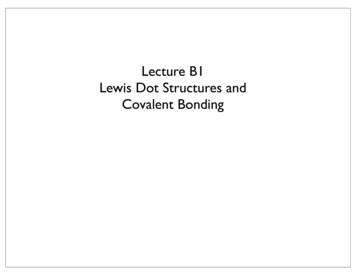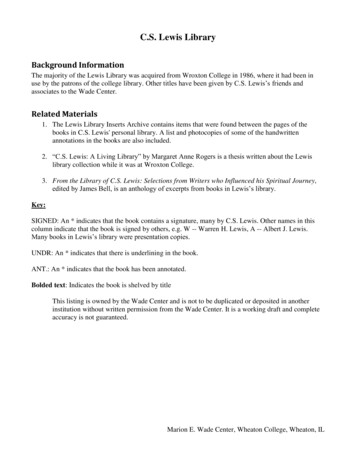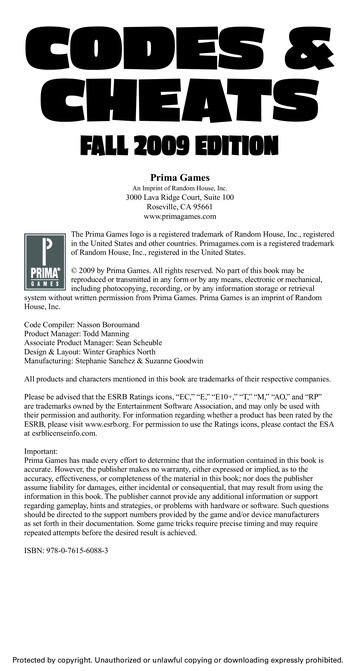
Transcription
Lecture B1Lewis Dot Structures andCovalent Bonding
G.N. Lewis & Linus PaulingTwo American ChemistsG. N. Lewis1875-1946Linus Pauling1901-1994
The Covalent Bond1. First proposed by G.N. Lewis in his seminal 1916J. Am. Chem. Soc. publication (before QM wasdiscovered!).2. Lewis proposed that Covalent bonds consist ofshared pairs of electrons. He created apowerful empirical formalism (Lewis dot structures)for understanding bonding in simple compounds.3. Linus Pauling created a picture of covalent bondingthat employed Quantum Mechanics (and won the1954 Nobel Prize for it).
G.N. Lewis, circa 1902 - the cubical atom.
G.N. Lewis, Journal of the American Chemical Society 38 (1916) 762.
G.N. Lewis, Journal of the American Chemical Society 38 (1916) 762.I2 molecule
.we still think about covalent bonds the way G.N. Lewis did.In contrast to ionic bond, electrons are shared, not transferred.if the atoms are identical, then electrons are equallyshared - an example of a perfectly nonpolar covalent bond.
In covalent bond formation, atoms go as far as possibletoward completing their octets by sharing electron pairs.Covalent bonds are drawn as lines.Lone pairs are drawn as pairs of dots.I II2 molecule
Lewis dot structures provide a simple,but extremely powerful,formalism for representing covalent bonding in molecules.a “single bond”, consisting of a pair of electrons.
Lewis dot structures provide a simple,but extremely powerful,formalism for representing covalent bonding in molecules.a nonbonding pair of electrons: a“lone pair”
Lewis dot structures provide a simple,but extremely powerful,formalism for representing covalent bonding in molecules.Note: no geometric information!
Lecture B1Systematic Method for CreatingLewis Dot Structures
Lewis Dot Structures can be produced by following a sequenceof steps. Let’s produce a Lewis Dot Structure for:NH4 (the ammonium ion).Step 1: Count valence electrons:N 54xH 4x1 4“ ” -1Total 5 4-1 8 electrons 4 bonds andlone pairs.
Lewis Dot Structures can be produced by following a sequenceof steps. Let’s produce a Lewis Dot Structure for:NH4 (the ammonium ion). Step 1: Count valence electrons:N 54xH 4x1 4“ ” -1Total 5 4-1 8 electrons 4 bonds andlone pairs.Step 2:Arrange the atoms (identify a centralatom, if possible).HH NHH
Lewis Dot Structures can be produced by following a sequenceof steps. Let’s produce a Lewis Dot Structure for:NH4 (the ammonium ion). Step 1: Count valence electrons:N 54xH 4x1 4“ ” -1Total 5 4-1 8 electrons 4 bonds andlone pairs.Step 2:Arrange the atoms (identify a centralatom, if possible).Step 3:Place electron pairs on the atoms aseither bonds or lone pairs.HH NHH
Lewis Dot Structures can be produced by following a sequenceof steps. Let’s produce a Lewis Dot Structure for:NH4 (the ammonium ion). Step 1: Count valence electrons:N 54xH 4x1 4“ ” -1Total 5 4-1 8 electrons 4 bonds andlone pairs.Step 2:Arrange the atoms (identify a centralatom, if possible).Step 3:Place electron pairs on the atoms aseither bonds or lone pairs.HH NHH
Lewis Dot Structures can be produced by following a sequenceof steps. Let’s produce a Lewis Dot Structure for:NH4 (the ammonium ion). Step 1: Count valence electrons:N 54xH 4x1 4“ ” -1Total 5 4-1 8 electrons 4 bonds andlone pairs.Step 2:Arrange the atoms (identify a centralatom, if possible).Step 3:Place electron pairs on the atoms aseither bonds or lone pairs.Step 4:Count electrons and compare withknown count. If octet rule is satisfied for allatoms and the electron count is right, you’redone.HH NHH8 valence electronsaround N!
Lecture B1Lewis Dot StructuresMultiple Bonds
G.N. Lewis, Journal of the American Chemical Society 38 (1916) 762.
.another example: Let’s produce a Lewis Dot structure for:acetone: (CH3)2CO.Step 1: Count the valence electrons:3 x C 126xH 6x1 6O 6Total 12 6 6 24 electrons 12 bondsor lone pairs.
.another example: Let’s produce a Lewis Dot structure for:acetone: (CH3)2CO.Step 2:Arrange the atoms: Identify a central atom.If you have C or O to choose from, go with C.H OH C CHHC HH
.another example: Let’s produce a Lewis Dot structure for:acetone: (CH3)2CO.Step 3:Place 12 electron pairs on the atoms.H OH C CHHC HH
.another example: Let’s produce a Lewis Dot structure for:acetone: (CH3)2CO.Step 3:Place 12 electron pairs on the atoms.H OH C CHHC HHNine Bonds, Three Lone Pairs
.another example: Let’s produce a Lewis Dot structure for:acetone: (CH3)2CO.Step 4:Check for the octet rule.oops -- only 6 e!H OH C CHHC HHNine Bonds, Three Lone Pairs
.another example: Let’s produce a Lewis Dot structure for:acetone: (CH3)2CO.Step 4:Check for the octet rule.Better!H OH C CHHC HHTen Bonds (one double bond), Two Lone PairsDone!
.another example: Let’s produce a Lewis Dot structure for:acetone: (CH3)2CO.Step 4:Check for the octet rule.H OH C CHHC HHThis takes practice, but then becomes tedious.Getting the polyatomic arrangement can be problematic.
How about Double 07 (Nitrogen)?Step 1: 10 valence electrons/five bonds and lone pairs
How about Double 07 (Nitrogen)?Step 1: 10 valence electrons/five bonds and lone pairsStep 2: Arrange atoms.N N
How about Double 07 (Nitrogen)?Step 1: 10 valence electrons/five bonds and lone pairsStep 2: Arrange atoms.Step 3: Fill in electron pairs and bonds.N N
How about Double 07 (Nitrogen)?Step 1: 10 valence electrons/five bonds and lone pairsStep 2: Arrange atoms.Step 3: Fill in electron pairs and bonds.N N
How about Double 07 (Nitrogen)?Step 1: 10 valence electrons/five bonds and lone pairsStep 2: Arrange atoms.Step 3: Fill in electron pairs and bonds.Step 4: Octet rule obeyed!N NA Triple Bond!
multiple bonds have higher bond dissociation energies.
A quantitative comparison of CC bondsN2 Bond Dissociation Energy: 941 kJ mol-1
bond lengths are inversely correlated withbond energies - shorter bonds are stronger.Double 07 is very strong!
Lecture B1Lewis Dot StructuresFormal Charge
Let’s produce a Lewis Dot structure for carbon disulfide, CS2.Step 1: Count valence electrons:C 42 x S 6 x 2 12Total 4 12 16 e/8 electron pairs.
Let’s produce a Lewis Dot structure for carbon disulfide, CS2.Step 1: Count valence electrons:C 42 x S 6 x 2 12Total 4 12 16 e/8 electron pairs.Step 2:Arrange the atoms. Go with Carbon in the center.SCS
Let’s produce a Lewis Dot structure for carbon disulfide, CS2.Step 1: Count valence electrons:C 42 x S 6 x 2 12Total 4 12 16 e/8 electron pairs.Step 2:Arrange the atoms. Go with Carbon in the center.SCStep 3:Fill in the electron pairs.S
Let’s produce a Lewis Dot structure for carbon disulfide, CS2.Step 1: Count valence electrons:C 42 x S 6 x 2 12Total 4 12 16 e/8 electron pairs.Step 2:Arrange the atoms. Go with Carbon in the center.SCStep 3:Fill in the electron pairs.S
Let’s produce a Lewis Dot structure for carbon disulfide, CS2.Step 1: Count valence electrons:C 42 x S 6 x 2 12Total 4 12 16 e/8 electron pairs.Step 2:Arrange the atoms. Go with Carbon in the center.SCStep 3:Fill in the electron pairs.Step 4:Check for the octet rule.S
Let’s produce a Lewis Dot structure for carbon disulfide, CS2.Step 1: Count valence electrons:C 42 x S 6 x 2 12Total 4 12 16 e/8 electron pairs.Step 2:Arrange the atoms. Go with Carbon in the center.SCSStep 3:Fill in the electron pairs.Step 4:Check for the octet rule.Good!
Let’s produce a Lewis Dot structure for carbon disulfide, CS2.Step 1: Count valence electrons:C 42 x S 6 x 2 12Total 4 12 16 e/8 electron pairs.Step 2:Arrange the atoms. Go with Carbon in the center.SCStep 3:Fill in the electron pairs.Step 4:Check for the octet rule.SBUT wait, what about?CSS
To decide between these two candidate structures, we needto calculate the formal charges on the atoms.
Less formal charge is better. Thus, SCS wins!SCS wins!
Carbon dioxide, CO2, is “isoelectronic”with carbon disulfide, CS2.
Nitrous oxide, N2O, is also isoelectronicwith carbon disulfide, CS2.
Lecture B1Lewis Dot StructuresResonance
When multiple Lewis Dot Structures exist that aredifferentiated only by the positions of the electrons (thepositions of the atoms are identical), the ACTUALstructure is a weighted average of these“resonance” structures.We predict that the three N-O bonds inthe nitrate ion are identical in length.
Another Example:We predict that the two C-O bonds inthe acetate ion are identical in length.
And Another Example: Benzene
Two resonance structures for benzene.We predict that all of the C-C bondsin benzene have the same length.
So normally, Chemists represent benzene like this:
Lecture B1Lewis Dot StructuresExceptions to the Octet Rule
In the benzene, the actual structure is the average ofthe possible resonance structures,but this is often not the case when resonance structures with a range offormal charge values are possible. In this case, the actual structure willbe a weighted average of the available resonance structures.A what?an example:Grades are often computed using a weighted average. Suppose thathomework counts 10%, quizzes 20%, and tests 70%.If Pat has a homework grade of 92, a quiz grade of 68, and a test grade of81, thenPat's overall grade (0.10)(92) (0.20)(68) (0.70)(81) 79.5How do we weight resonance structures?
An example: Which is the better Lewis Dot representation forthe phosphate ion, PO43-?
An example: Which is the better Lewis Dot representation forthe phosphate ion, PO43-?We have to look at the formal charge arguments here.The structure shown at right has fewer formal charges, but.P has 10 electrons - is this ok?
An example: Which is the better Lewis Dot representation forthe phosphate ion, PO43-?If 10 electrons is okay for P, thenless charge is better.
An example: Which is the better Lewis Dot representation forthe phosphate ion, PO43-?If 10 electrons is okay for P, thenless charge is better.P can use its d electrons to expand its valence shell.More than 8 electrons "hypervalent"
What if a second double bond is added?- formal charge on that O goes from -1 to 0- formal charge on P goes from 0 to -1- total number of formal charges is unchanged.- electron count on P goes from 10 to 12.If 12 electrons is okay for P, thenis it better to charge P or O?
Actually, all of these resonance structures contribute to the weightedaverage resonance hybrid that is observed.lower weightingfactorhigher weightingfactorlower weightingfactorWe need more information todetermine the exact weightingfactors.Pauling will introduce theconcept of electronegativity tohelp with this.
Final example: Rank these Lewis dot resonancestructures for cyanate (NCO-) from best to worst:
Final example: Rank these Lewis dot resonancestructures for cyanate (NCO-) from best to worst:123Again, Pauling's conceptof electronegativity willhelp with this.
Another exception to the octet rule:1.Be, B, and Li can be electron deficient.examples:note: no formalcharges here.
Another exception to the octet rule:1.Be, B, and Li can be electron deficient.examples: what about this resonance structure?
Another exception to the octet rule:1.Be, B, and Li can be electron deficient.examples: a smaller weighting factor for this structure. 100-1
Another exception to the octet rule:2.Non metals in period 3 or higher can accommodatemore than 8 electrons by employing d-orbitals.examples:We talked about this one before.
Another exception to the octet rule:2.Non metals in period 3 or higher can accommodatemore than 8 electrons by employing d-orbitals.examples:Sulfur can do this too.
Another exception to the octet rule:2.Non metals in period 3 or higher can accommodatemore than 8 electrons by employing d-orbitals.examples:Even Xenon gets in on the act!
Lecture B1Bond Polarity andElectronegativity
Pauling realized that covalent bonds between different nucleiwill not be symmetric in electron density (probability):Linus Pauling1901-1994
This will lead to a pair of net positive and negative partialcharges that will result in a DIPOLE MOMENT for themolecule:ordipole moment charge x distanceLinus Pauling1901-1994
This will lead to a pair of net positive and negative partialcharges that will result in a DIPOLE MOMENT for themolecule:dipole moment charge x distance1 Debye 1D 3.336 x 10-30 C mNamed after Peter J. W. DebyeDutch PhysicistNobel Prize in Chemistry 1936Peter J. W. Debye1884-1966
This will lead to a pair of net positive and negative partialcharges that will result in a DIPOLE MOMENT for themolecule:HCl Dipole Moment: 1.08DLinus Pauling1901-1994
Pauling proposed a number to quantitate the ability of an atom topolarize a bond: "Pauling Electronegativity"χ (chi)Electronegativity ranges from 0.7 to 4.0. It is unitless!
Three terms that are often confused:Ionization energy: the energy required to remove an electron from anatom or ion.Electron affinity: the energy change associated with the addition of oneelectron to an atom or ion.Electronegativity: the ability of an atom in a molecule to draw bondingelectrons to itself. Important: this is a dimensionlessparameter - not an energy.
Dipole Moments and Pauling ElectronegativityHCl Dipole Moment: 1.08DχCl - χH 3.0 - 2.1 0.9Electron density is higher onthe atom with higherelectronegativity.Linus Pauling1901-1994
Dipole Moments and Pauling ElectronegativityHF Dipole Moment: 1.83DχF - χH 4.0 - 2.1 1.9HCl Dipole Moment: 1.08DχCl - χH 3.0 - 2.1 0.9HBr Dipole Moment: 0.82DχBr - χH 2.8 - 2.1 0.7Electronegativity differencescorrelate with dipole moment values.Linus Pauling1901-1994
Rank these Lewis dot resonance structures forcyanate (NCO-) from best to worst:1We can go back and useelectronegativity to rank Lewisdot resonance structures.2χN 3.0 and χO 3.5.Thus the negative charge prefersto reside on the Oxygen.3
Generalizing, any bond will possess a bond dipole moment with amagnitude that is proportional to the difference in electronegativitybetween the bonding partners. HH NHHFor example, even though NH4 has no dipole moment, the four covalent bonds inthe ammonium ion are between two elements with different electronegativities:χN - χH 3.0 - 2.1 0.9, and therefore EACH has a bond dipole moment.The fact that the four dipole moments cancel is a matter ofgeometric structure. That is the NEXT topic -- VSEPR Theory!
Lewis Dot Structures can be produced by following a sequence of steps. Let’s produce a Lewis Dot Structure for: NH 4 (the ammonium ion). Step 1: Count valence electrons: N 5 4 x H 4 x 1 4 “ ” -1 Total 5 4-1 8 electrons 4 bonds and lone pairs. Step 2:!










